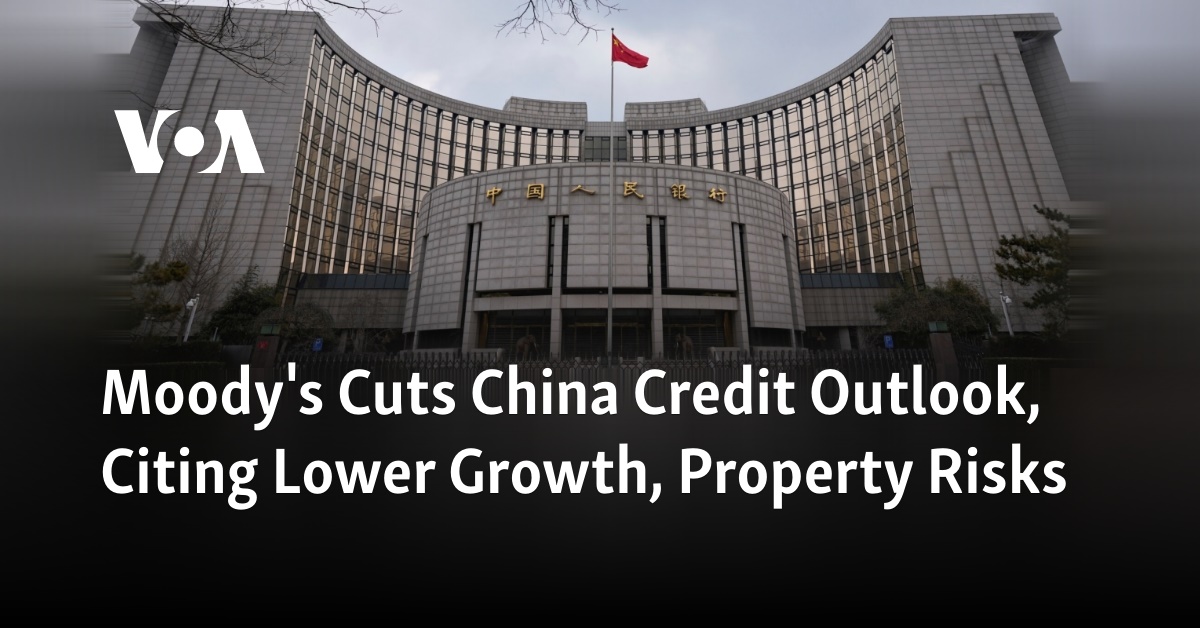Moody’s has revised its credit outlook for China, citing decreased economic growth and potential risks in the property market.

Moody’s, a ratings agency, downgraded China’s government credit ratings from stable to negative on Tuesday. This reflects growing international worry about the effects of increasing local government debt and a worsening real estate crisis on the economy of the world’s second-largest country.
Moody’s stated that there is increasing evidence that the government will need to offer additional financial assistance to heavily indebted local governments and state-owned enterprises. This could potentially pose significant risks to China’s fiscal, economic, and institutional stability. Therefore, the downgrade was necessary.
Moody’s stated that the revised forecast also takes into account the heightened dangers associated with consistently low economic growth in the medium-term, as well as the continued reduction of the real estate industry.
On Tuesday, China’s leading stocks dropped to levels not seen in nearly five years due to concerns over the country’s economic growth. Talk of a potential downgrade by Moody’s further dampened investor sentiment, and Hong Kong stocks also continued to decline.
According to a source familiar with the situation, China’s main government-owned banks, who were previously known to be propping up the yuan, significantly increased their selling of U.S. dollars in response to Moody’s recent statement. As a result, there was minimal movement in the value of the yuan by the end of the afternoon.
The price of protecting China’s government debt from a potential default reached its peak since mid-November.
According to Ken Cheung, the chief Asian FX strategist at Mizuho Bank in Hong Kong, the current focus of the markets is on the property crisis and slow growth, rather than the immediate risk of sovereign debt.
Moody’s decision marked the initial adjustment to its perspective on China since it lowered its rating to A1 in 2017, attributing it to anticipated deceleration in economic growth and increasing debt levels.
On Tuesday, Moody’s confirmed China’s A1 ratings for both local and foreign-currency issuers. They noted that the economy remains resilient, but predicted a decline in annual GDP growth to 4.0% in 2024 and 2025, with an average of 3.8% from 2026 to 2030.
Moody’s has downgraded its outlook prior to the Central Economic Work Conference, an annual event that sets the economic agenda. This conference is anticipated to take place in mid-December, and government advisors are pushing for a stable growth goal for 2024, along with increased stimulus measures.
Experts suggest that the A1 rating is sufficiently strong within the category of investment-grade, therefore a decrease is not likely to cause international funds to have to sell off their assets. The two other prominent rating agencies, Fitch and Standard & Poor’s, also rate China at A+, which is equal to Moody’s rating. Both agencies have a positive outlook.
The Finance Ministry of China expressed disappointment with Moody’s decision and stated that the economy will continue to recover and show a positive trend. It also mentioned that risks related to property and local government are manageable.
The ministry stated that Moody’s worries about China’s potential for economic growth, financial stability, and other factors are unwarranted.
Struggling for traction
Many experts predict that China’s economic growth is expected to reach the government’s goal of approximately 5% this year. However, this is in contrast to the slowed growth in 2022 due to the impact of COVID-19, and economic activity remains inconsistent.
The economy has faced challenges in making a robust recovery after the pandemic due to various factors such as a worsening housing market, concerns about local government debt, slower global growth, and tensions in international relations.
A series of policy assistance efforts have only had a limited positive impact, increasing the urgency for authorities to implement additional stimulus measures.
Experts generally concur that China’s development is slowing down from its rapid pace in the previous decades. Several argue that Beijing must shift its economic strategy away from excessive dependence on debt-driven investment and towards a focus on consumer spending.
The previous week, Pan Gongsheng, the leader of China’s central bank, promised to maintain a supportive monetary policy to bolster the economy. However, he also emphasized the need for structural changes to decrease dependence on infrastructure and real estate for economic growth.
Deeper in debt
Economists warn that municipalities burdened by debt due to excessive investments, declining profits from land sales, and high expenses to combat COVID are now a significant threat to the economy.
In 2022, the latest statistics from the International Monetary Fund (IMF) show that local government debt in China reached 92 trillion yuan, equivalent to 76% of the country’s economic output. This is an increase from 62.2% in 2019.
In October, China unveiled a plan to issue 1 trillion yuan ($139.84 billion) in sovereign bonds by the end of the year to help kick-start activity, raising the 2023 budget deficit target to 3.8% of gross domestic product (GDP) from the original 3%.
In recent months, the central bank has made small reductions in interest rates and injected additional funds into the economy.
However, throughout the year, international investors have remained pessimistic about China.
Goldman Sachs reported that there was a significant increase in capital leaving China in September, reaching $75 billion. This is the highest monthly amount since 2016.
($1 = 7.1430 Chinese yuan renminbi)
Source: voanews.com




